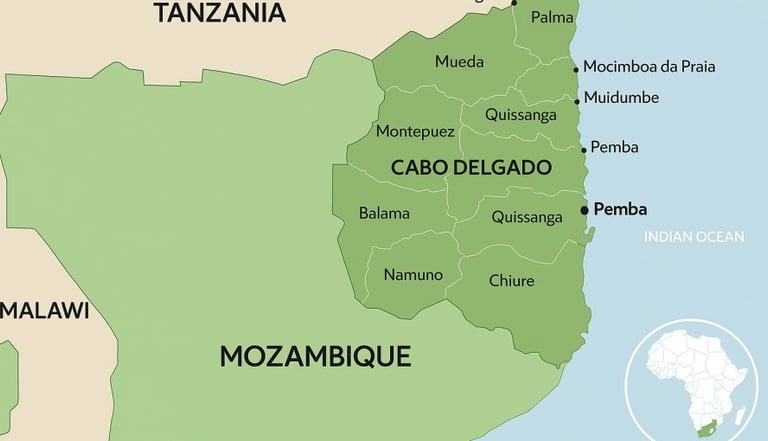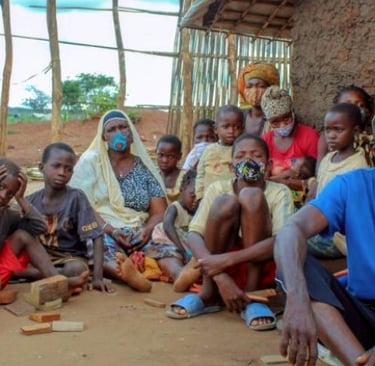Cabo Delgado Insurgency: Why Mozambique Needs Change
Explore the causes of the Cabo Delgado insurgency in Mozambique, from poverty to neglect, and why borderland integration is key to lasting peace.
10/14/20253 min read
Cabo Delgado Insurgency: Why Mozambique Needs Change
Since 2017, the Cabo Delgado insurgency has turned a resource-rich corner of northern Mozambique into a battleground. Led by an Islamic sect known as Al Shabaab, this conflict has killed over 1,000 people and displaced more than 200,000, drawing global attention from powers like Russia and France. But what’s really driving this unrest, and why haven’t military interventions stopped it? Let’s unpack the Mozambique conflict, diving into its roots in poverty, neglect, and porous borders, and explore a path toward lasting peace


The Roots of the Cabo Delgado Insurgency
Cabo Delgado, a province brimming with diamonds, natural gas, and rubies, should be a beacon of prosperity. Instead, it’s a stark example of a neglected borderland. For decades, Mozambique’s central government has overlooked this region, leaving locals without basic services like schools, hospitals, or reliable roads. Worse, communities are often evicted from their ancestral lands to make way for resource extraction, with little to no benefit trickling back to them.
This neglect breeds resentment. Young people, facing unemployment and poverty, feel disconnected from the state. As Mutasa and Muchemwa (2021) note, the insurgency has caused over 1,000 deaths and displaced 200,000 people, numbers that have likely grown since. The frustration isn’t just local—it’s fueled by a porous border with Tanzania, where weak enforcement allows smuggling of arms, drugs, and even extremist ideologies.
Poverty and Porous Borders: A Perfect Storm
The Cabo Delgado insurgency thrives on a toxic mix of poverty and border porosity. The region’s underdevelopment—marked by a lack of infrastructure and state services—has left locals with little loyalty to the government. Many young people, seeing no path to a better future, are drawn to insurgent groups or illicit activities like smuggling.
The Mozambique-Tanzania border is a key player in this crisis. Its permeability, due to inadequate policing, allows insurgents to move freely, smuggle weapons, and forge ties with groups across the border. Ethnic connections that span both countries further complicate the situation, turning a local conflict into a regional one. If unaddressed, the Mozambique conflict risks spreading to other parts of the country and the Southern African region, as warned by researchers Hlongwana, Chakawa, and Lazaro (2025).
Read more about global terrorism trends at United Nations | Peace, dignity and equality on a healthy planet
Why Military Interventions Fall Short
In response to the insurgency, Mozambique has leaned on military support from the Southern African Development Community (SADC), Rwanda, and even global powers. But as of 2021, these efforts haven’t delivered lasting peace. Why? Insurgents use guerrilla tactics, blending into communities and exploiting the region’s rugged terrain. Military solutions alone can’t address the deeper issues of Cabo Delgado poverty and marginalization.
Think of it like treating a fever without curing the infection. Soldiers can push back insurgents temporarily, but without tackling the root causes—poverty, neglect, and weak borders—the conflict will persist.


A Better Way: Borderland Integration
So, what’s the solution? The research points to borderland integration as a game-changer. Instead of treating Cabo Delgado as a forgotten outpost, Mozambique and Tanzania could collaborate to bring this region into the national and regional fold. This means:
Investing in Infrastructure: Build schools, hospitals, and roads to give locals a stake in their future.
Equitable Resource Sharing: Ensure profits from natural resources benefit local communities, not just elites.
Stronger Border Management: Tighten border security to curb smuggling while fostering legitimate trade.
This approach aligns with the concept of “positive peace,” which goes beyond stopping violence to address the grievances fueling it. International support, from humanitarian aid to development funding, can amplify these efforts
Lessons from Cabo Delgado
The Cabo Delgado insurgency isn’t just a Mozambican problem—it’s a warning for borderlands across Africa. Colonial-era boundaries, which split cultural groups, combined with government neglect, have created fertile ground for unrest. Informal regional ties, like those across the Mozambique-Tanzania border, can be exploited by groups like Al Shabaab Mozambique to spread instability.
Researching this conflict wasn’t easy. Security issues limited access to parts of Cabo Delgado, and the study relied on qualitative methods like semi-structured interviews. Yet, the findings are clear: addressing poverty and marginalization is critical to stopping the insurgency. Future research should explore the social and cultural impacts of the conflict and the role of international terrorism.
For more on regional conflicts, see the Vision of Humanity | Destination for Peace
A Call to Action
The Cabo Delgado insurgency is a wake-up call. Mozambique’s government must prioritize its borderlands, investing in people, not just resources. By addressing poverty, strengthening borders, and fostering regional cooperation, the country can build a future where young people see opportunity, not rebellion.
You can make a difference too. Share this post to raise awareness, and wait for more post of this from us , or support organizations providing humanitarian aid in Mozambique. Together, we can push for a more inclusive, peaceful future.
we are committed to providing the finest academic work at affordable prices, while safeguarding your information with the highest security measures.
Check out our social media!
Website infomation
Legal information


Customer information
Site map
Here at the beaver press:
